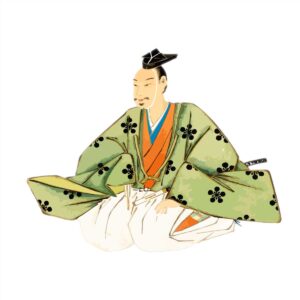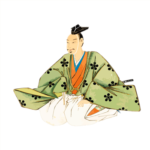
Tea master, founder of the Oribe school. Lord of Nishioka Castle in Yamashiro Province (Kyoto Prefecture).
Born in 1544. Nickname was Sasuke, first name Kageyasu, later Shigenori. He was appointed to the post of “Oribe Masa” and was called “Oribe” in Japanese. He was given the title of “Kin Fu” by Zen master Shunya of Daitokuji Temple. He was born in Mino Province (Gifu Prefecture) and belonged to the Toki clan, but later served under Nobunaga and became a Hatamoto-banner. In 1598, he passed the title to his son, Shigetsugu Yamashiro, and retired. In 1614, he went into battle on the Tokugawa side in the Osaka Winter Campaign, but his youngest son Kuhachiro Shigeyuki, who was a surname of Hideyori at Osaka Castle, betrayed him to Toyotomi and had his retainer Kimura Muneyoshi set fire to Nijo Castle and attacked the castle with 500 warriors. On June 11, 1615, he committed seppuku at his residence in Fushimi. Four of his men were also convicted of the same crime. He was 72 years old. Oribe was an excellent warrior, and also came from a family where his father Shigesada, later called Kan’ami, was a friend of Hideyoshi.
He studied tea ceremony under Rikyu, and his tea name is found in documents from 1582 (Tensho 10), when he was 39 years old.
Later, he became a member of Hideyoshi’s court, and after Rikyu’s death, he was commissioned by Ieyasu to build the Fushimi Castle mountain village, and after Hideyoshi, he became a tea ceremony master for Shogun Hidetada. In 1610, he was invited to teach at Edo Castle. In this way, Oribe was revered by court nobles, samurai, and tea masters in Kyoto and Sakai as a master of the tea ceremony and a teacher of the art of tea ceremony.
This is clearly attested to in the Tamonin Diary and Sunpu Seiji Roku, which states, “The lords of Sunpu, beginning with Terumasa, respect Oribe’s tea ceremony, and all the lords in the palace, including Terumasa, sit down to the dishes served by Oribe. Oribe was always a teacher of the way. Oribe always respected Rikyu, the master of the Way, and his parental love was not only for Rikyu, but also for Oribe’s master. The tea ceremony is also known from the fact that he received a Namida chashyaku as a relic. Oribe’s disciples in the tea ceremony were numerous, including feudal lords, court nobles, monzeki, and merchants, and among them were Chikasamyakuin Shin’yun, who left behind a renga poem “Ryogin hyakuinmaki” with Oribe, and Hon’ami Koetsu, a potter.
Oribe’s tea ceremony style, because of its time and position, had an open, colorful style that was newly formed in contrast to Rikyu’s contractional and tasteless internal orientation of the tea ceremony. For example, Oribe designed an unusual Oribe lantern with a four-minute view and a six-minute walk, compared to Rikyu’s six-minute view and four-minute walk, and he laid long and short hewn stones and long stones on the ground, planted a pine tree with a dead tree and flowers, and designed a high water bowl, a precious stone, colored paper, a lacquered floor frame, etc. He also combined the tea ceremony seat with a companion seat or a chained room. In the field of ceramics, he sent his own designs to Seto, Mino, Iga, Bizen, Karatsu, and even to Korea, and produced powerful new styles of ceramics such as the so-called “strained or distorted” and “heuge-taru-mono” styles. This was in response to the Momoyama mood seen in the exuberant gold and blue brilliant paintings on the walls and, in part, from a taste for the diverse taste of the Nanban (Southern barbarians). Oribe’s style was so impressive that even the Koreans were astonished, saying, “Oribe Furuta is the best in Japan at all times,” and “He plants flowers and bamboos, makes teahouses, and seeks a title with a hundred gold pieces. It was his disciple Kobori Enshu who eventually succeeded this Oribe style within the framework of the feudal system and organized it into a style of painting.








